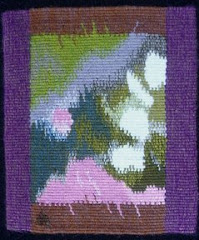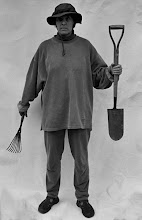
On Saturday, September 12, I attended the British Tapestry Group’s Conference Day, at the Stirling Smith Art Gallery and Museum, in Stirling, Scotland, just down hill from the castle.
Standing outside, waiting for the doors to open, who should I bump into but Linda Wallace, a fellow board member, and recent Co-Director of ATA. She had come all the way from British Columbia, on the west coast of Canada, so I was not the only North American in attendance!
It was great to see so many tapestry weavers gathered in one place. I had a chance to talk with old acquaintances Joan Baxter and Louise Martin and met lots of new people too.
The conference included an exhibition called Weaving Within, Small Format Tapestries Woven by the British Tapestry Group.
There are 91 tapestries woven by 55 artists, including some fellow bloggers like Tommye Scanlin (USA), Marilyn Rea-Menzies (New Zealand), Meab Warburton (France) and Elaine Duncan(Canada). Other tapestries from North America are by Pamela Davis and Linda Wallace. Membership in the BTG is open to all.
“Out of the Ashes”
This exhibition is very impressive. In fact, my husband was so impressed that I began to wonder if I should be insulted; after all this is not the first tapestry exhibition he has seen, and all the others are ones I have participated in myself….. There is a lot of talent and training in the group, and there are some very innovative works included, such as the 3D works by Margaret Crowther; shaped tapestries by a number of artists, many unusual materials like stainless steel in Linda Wallace’s piece, beads, painted pumpkin seeds, discs of fabric, various unusual fibers; knotted tapestry by Anne Jackson and the tapestry collages of Clare Coyle.
The more traditional tapestries also represent a wide range of designs and styles, and I have many favorites among these. Although there is no printed catalog, there is a brochure that includes one image per artist. It will be for sale sometime this month from the BTG website. (Sorry about the poor image quality, my copy is a bit wrinkled from use!)
“Weaving Within” hangs at both the Stirling Smith Art Gallery and Stirling Castle, until Nov 8. So hop on a plane and a train and go! You’ve got a whole week!
The conference consisted of a day of lectures and a second day of workshops. I only attended the lecture day, and it was really fascinating. There were 4 main speakers, interspersed with numerous short presentations by participants in the exhibit.
I really enjoyed hearing from these tapestry artists, about the work they submitted for the exhibition, and I would give them all credit here, except that I mislaid my program. Sorry….
Joan Baxter spoke about the future of tapestry as a viable art form in the 21st Century, and asked us to think seriously about w
Although Sara Brennan was listed on the conference program, she was not there, and instead we were treated to a delightful talk by Amanda Gizzi, about her work and her inspirations. She managed to be honest, insightful, profound and amusing all at once. I loved her comment about a man who dropped something, and as he got down to look for it on the floor, he happened to look out “a wee circular window,” and saw the world from a different perspective altogether.
Her work focuses on ordinary subjects, often with food and cooking. I love the tapestry titled “Pickled Peaches.”
Rudi Richardson spoke about his years in San Francisco, weaving tapestries for the legendary Mark Adams. This was very informative and filled in a lot of gaps in my knowledge of Adams, and San Francisco tapestry.
Dina Ward spoke about tapestry history, with many examples from around the world. She works at the Burrell Collection, which is in Glasgow, and has a superb tapestry collection. If I’d known, I might have been able to fit in a visit, but as it is, I’ll have to wait until next time I’m in the area. I also found out there are some interesting tapestries in Berne, Switzerland, which is just 45 minutes on the train from where we are staying now.
Dina said they are known as “The Burgundian Loot,” which is very intriguing!
I wish I could tell you more, but I decided to just relax and enjoy the experience, so unfortunately my meager notes are not that helpful. Next time you’ll just have to go yourself!
“WaterLily” by Tommye Scanlin












